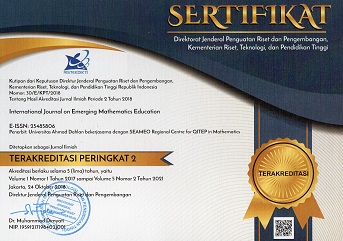Learning 2-Dimensional and 3-Dimensional Geometry with Geogebra: Which Would Students Do Better?
Abstract
The purpose of this study is to examine the geometric thinking of young children who worked with GeoGebra to learn two-dimensional (2-D) and three-dimensional (3-D) geometry. GeoGebra is an open sourced dynamic mathematics software which is applicable for learning mathematics from primary school to secondary school and to higher education. Thirty pupils studying in second grade (Year 2) at a school located in Pontian, a district in one of the Malaysian state participated in the study. They attended GeoGebra sessions to construct and analyze dynamics of two-dimensional and three-dimensional geometry after learning these topics in the conventional setting. Pretest and posttest on two-dimensional and three-dimensional spatial ability based on Van Hiele level of geometric thinking were administered to the pupils. The comparison between pretest and posttest results demonstrate significant enhancement in visualization and informal deduction for both 2-D and 3-D geometry. Moreover from the intervention, the students benefit most in analyzing 3-D and visualizing 2-D geometry. Interestingly, skills and knowledge acquired through activities using GeoGebra in student-centered learning environment could be successfully transferred to paper and pencil test.
Keywords
Full Text:
PDFReferences
Abdullah, A.H., & Mohini, M. (2008). The Use of Circle Learning Module, based on KDE Interactive Geometry (KIG) Software on Student's Geometrical Thinking Level. In: International Conference on Education Innovation (ICEI 2008), 2008, Legend Hotel, Kuala Lumpur.
Battista, M. T. (2003). Shape Makers. Emeryville. CA: Key Curriculum Press.
Fathurrohman, M., Porter, A.L., & Worthy, A.L. (2017). Teachers' real and perceived of ICT supported-situation for mathematics teaching and learning. International Journal on Emerging Mathematics Education, 1(1), 11-24.
Idris, N. (2009). Enhancing students' understanding in calculus trough writing. IEJME-Mathematics Education, 4(1), 36-55.
Ismail, Z., & Kasmin, M. (2007). Creating Islamic art with interactive geometry software. Smart Teaching & Learning: Re-engineering ID, Utilization and Innovation of Technology, 2, 1214-1220.
Meng, C.C., & Idris, N. (2012). Enhancing students' geometric thinking and achievement in solid geometry. Journal of Mathematics Education, 5(1), 15-33.
Pallant, J. (2010). SPSS survival manual: A step by step guide to data analysis using SPSS. Maidenhead.
Rajagopal, S., Ismail, Z., Ali, M., & Sulaiman, N. (2015). Attitude of secondary students towards the use of GeoGebra in learning loci in two dimensions. International Education Studies, 8(13), 27.
Tay, B.L. (2003). A van Hiele-based instruction and its impact on the geometry achievement of Form One students. Unpublished master's dissertation. Malaysia: University of Malaya.
Tutkun, O.F., & Ozturk, B. (2013). The effect of GeoGebra mathematical software to the academic success and the level of Van Hiele geometrical thinking. International Journal of Academic Research, 5(4), 22-28.
Van Hiele, P.M. (1986). Structure and Insights: A Theory of Mathematics Education. Orlando: Academic Press.
DOI: http://dx.doi.org/10.12928/ijeme.v1i2.5541
Refbacks
- There are currently no refbacks.
Copyright (c) 2017 Zaleha Ismail, Syairatul Nadiah Abd Rahman

This work is licensed under a Creative Commons Attribution 4.0 International License.
International Journal on Emerging Mathematics Education
Kampus 2 Universitas Ahmad Dahlan
Jalan Pramuka No. 42, Pandeyan, Umbulharjo, Yogyakarta - 55161
Telp. (0274) 563515, ext. 4902; Fax. (0274) 564604
Email: ijeme@uad.ac.id
p-ISSN: 2549-4996 | e-ISSN: 2548-5806
This work is licensed under a Creative Commons Attribution 4.0 International License

